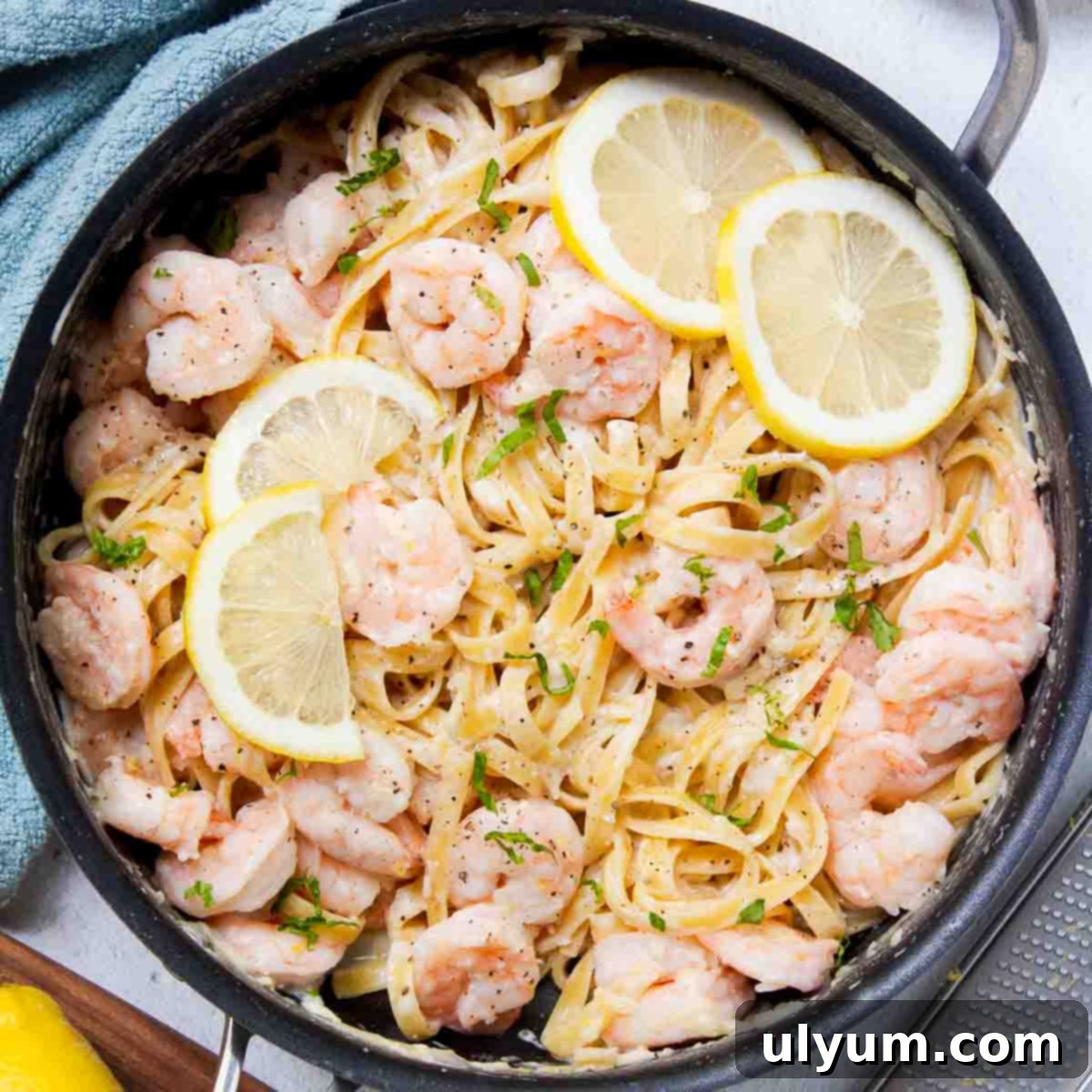Easy One-Pot Lemon Garlic Shrimp Pasta: Your New Favorite 30-Minute Weeknight Meal
Dive into the world of effortless gourmet cooking with this incredible **One-Pot Lemon Garlic Shrimp Pasta**. Featuring plump, fresh shrimp, rich Parmesan cheese, and a vibrant burst of fresh lemon juice and zest, this recipe delivers a truly sensational seafood dinner without the usual fuss. It’s the ultimate solution for a delicious meal that’s both quick to prepare and easy to clean up, making it a standout choice for any occasion.
This streamlined cooking method begins by perfectly sautéing raw shrimp in butter infused with aromatic garlic. Once tender and pink, the shrimp is briefly set aside to prevent overcooking. The magic continues in the same pot, where pasta simmers directly in a luxurious mixture of milk and chicken broth. This unique technique allows the pasta to absorb the flavorful liquids, releasing its starches to create a naturally light, creamy, and irresistible sauce. The grand finale involves stirring in the cooked shrimp, a generous helping of Parmesan, and the bright, zesty notes of lemon, culminating in a dish that’s as impressive as it is simple.
Whether you’re a beginner home cook eager to explore seafood, planning a special date night, or hosting a casual dinner party, this lemon garlic shrimp pasta is guaranteed to impress. Its bold, savory flavors and creamy texture will make it an instant favorite in your recipe rotation, proving that restaurant-quality meals are perfectly achievable right in your own kitchen.
Enjoy this wonderfully creamy and flavorful dish with its bold and savory notes. It’s poised to become one of your new go-to simple recipes, celebrated for its minimal effort and maximum taste.
This post contains affiliate links. As an Amazon Associate, I earn from qualifying purchases.
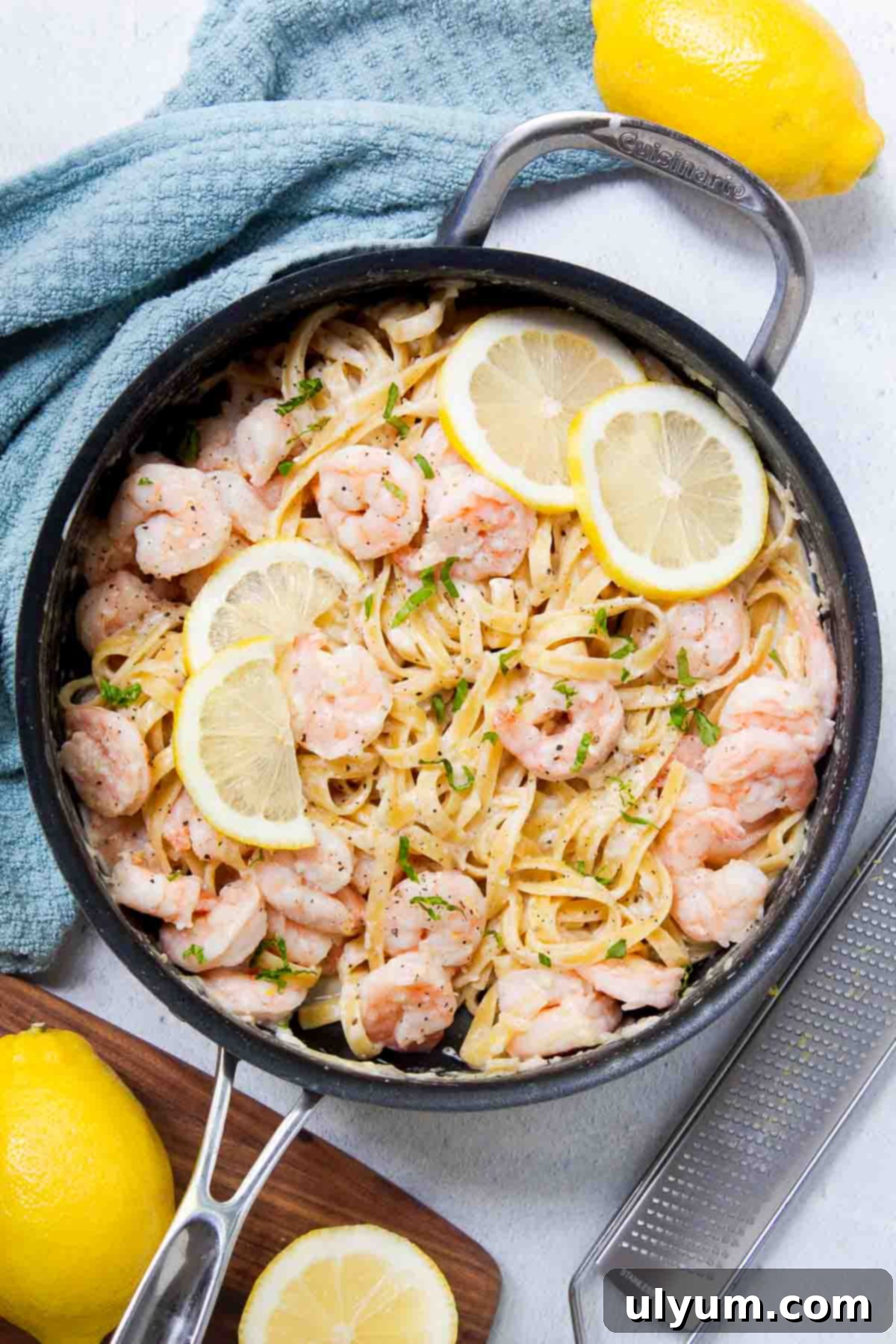
If you enjoy the convenience and flavor of one-pot dishes, you’ll definitely want to try this one-pot ground beef pasta and this indulgent one-pot rigatoni for equally delicious and simple meal solutions.
Recipe Highlights: Why You’ll Love This Dish
- Effortless Excellence: This isn’t just an easy recipe; it’s a culinary triumph in a single pot. You’ll achieve a restaurant-quality meal with minimal steps, making it perfect for those times you crave something special without spending hours in the kitchen.
- Lightning-Fast Dinner: In just about **30 minutes**, you can have a piping hot, satisfying meal on the table. This makes it an ideal dish for bustling weeknights when time is of the essence, or when you need a quick yet impressive meal.
- Simplified Cleanup: The ultimate perk of a one-pot meal! With only one pot to wash, cleanup is a breeze, leaving you more time to enjoy your evening. Say goodbye to piles of dishes and hello to stress-free cooking and tidying.
Essential Ingredients for Your One-Pot Masterpiece
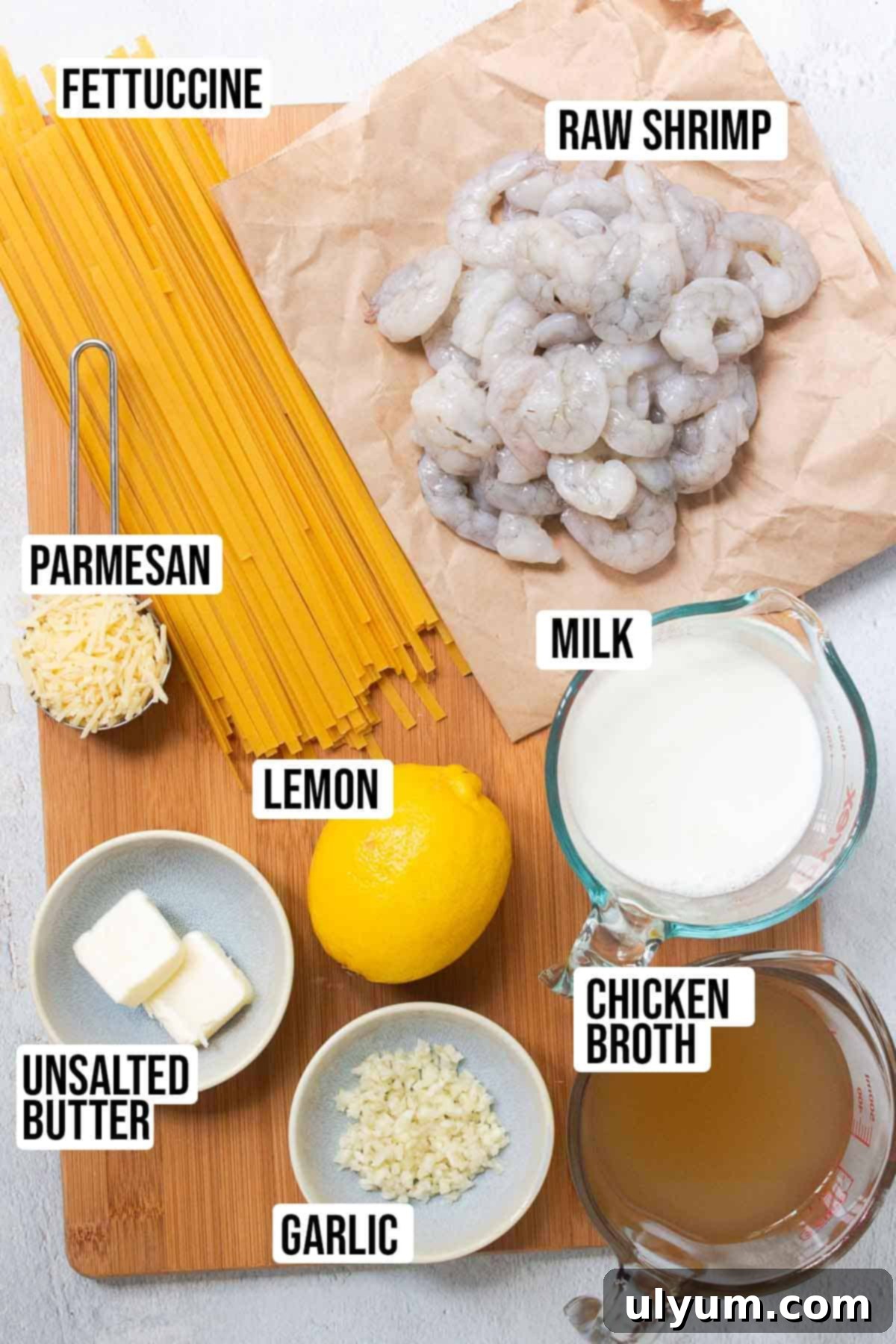
- Unsalted Butter: The foundation of our rich flavor. Using unsalted butter allows you to control the overall saltiness of the dish more precisely.
- Raw Shrimp: You’ll need about a pound of raw shrimp, ideally peeled and deveined to save prep time. Medium to large shrimp work best here, offering a satisfying bite.
- Garlic: Four cloves, minced. Fresh garlic is key for that pungent, aromatic flavor that pairs so beautifully with lemon and shrimp. Don’t be shy!
- Milk: Whole, 2%, or even skim milk will work. The fat content will affect the final creaminess; whole milk provides the richest sauce. It’s essential for developing the creamy base of your pasta.
- Chicken Broth: Adds a depth of savory flavor to the pasta. Opt for low-sodium broth to manage salt levels.
- Pasta: Uncooked fettuccine is recommended for its broad surface area, which perfectly coats with the creamy sauce. Other long pasta shapes like linguine or spaghetti also work well.
- Parmesan Cheese: Freshly shredded or grated Parmesan melts into a smooth, savory sauce, adding a crucial umami depth. Its salty, nutty profile is indispensable.
- Lemon: You’ll need one fresh lemon for both its juice and zest. The zest provides an intense burst of citrus aroma, while the juice adds bright acidity that cuts through the richness and highlights the shrimp.
- Salt and Pepper: Kosher salt and freshly ground black pepper, to taste. These basic seasonings enhance all the other flavors in the dish.
Always refer to the full recipe card below for exact quantities and detailed measurements to ensure perfect results every time.
Step-by-Step Guide to Perfect One-Pot Lemon Garlic Shrimp Pasta
Follow these simple steps to create a truly delightful one-pot meal with minimal effort.
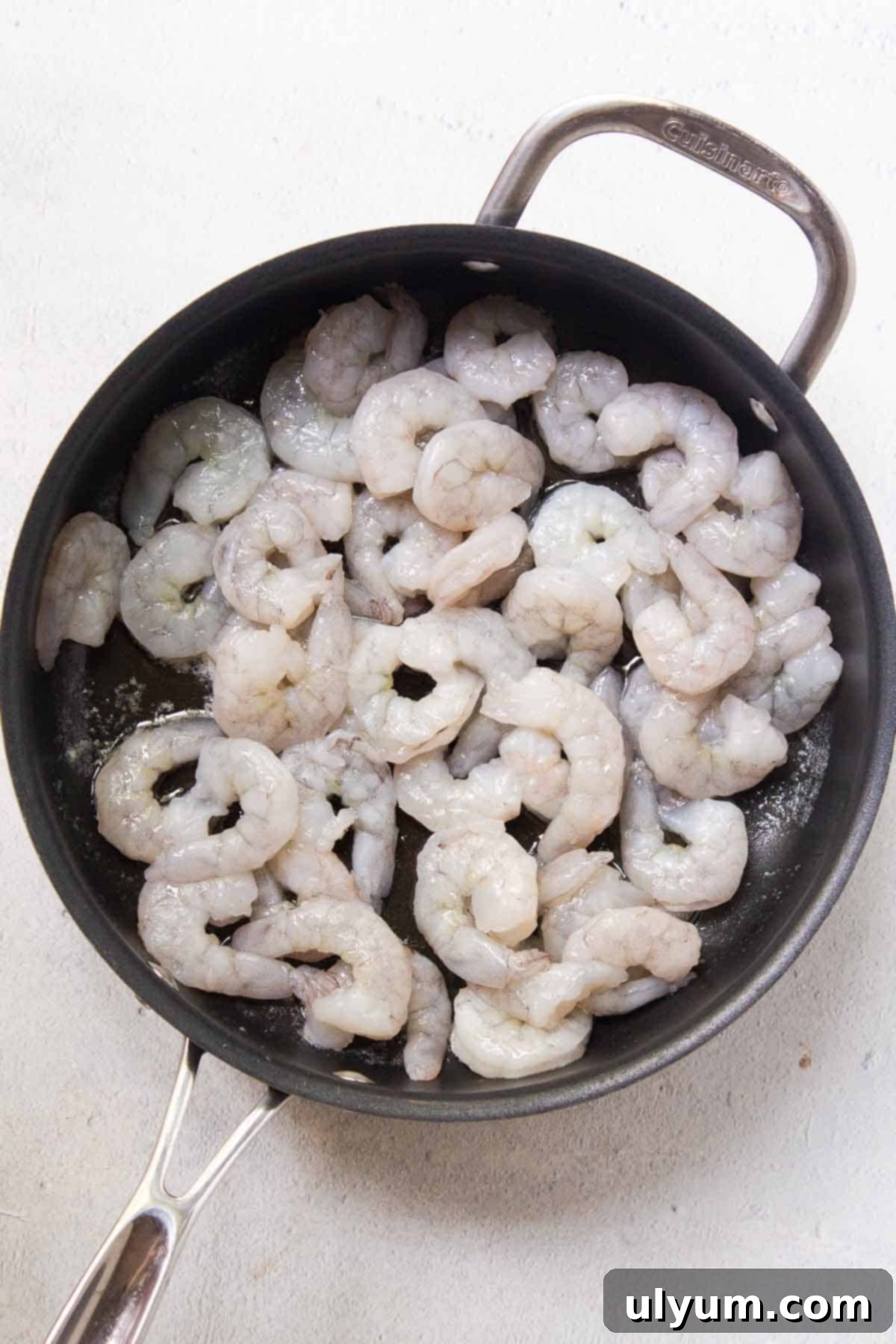
1. Sauté the Shrimp: In a large pot or a spacious skillet, melt the butter over medium heat. Once melted and shimmering, add your raw, peeled, and deveined shrimp. Season generously with salt and pepper. Cook for a few minutes until the shrimp begins to turn pink and curl, indicating it’s nearly cooked through. Be careful not to overcrowd the pan; cook in batches if necessary.
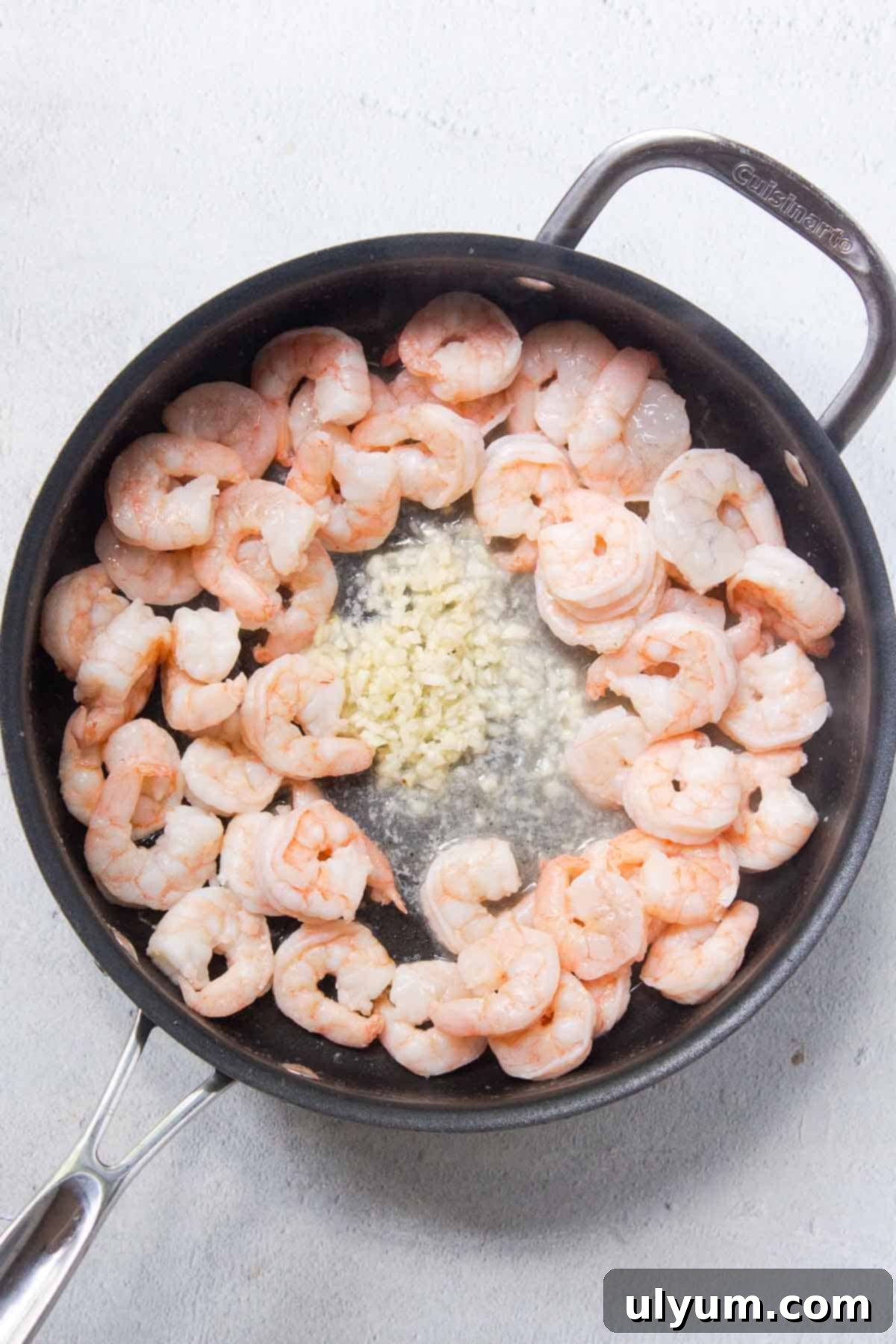
2. Infuse with Garlic: Just before the shrimp is fully cooked, add the minced garlic to the pan. Sauté for about 1 minute, stirring constantly. This quick sauté allows the garlic to become fragrant and infuse the butter, creating a delicious base, without burning.
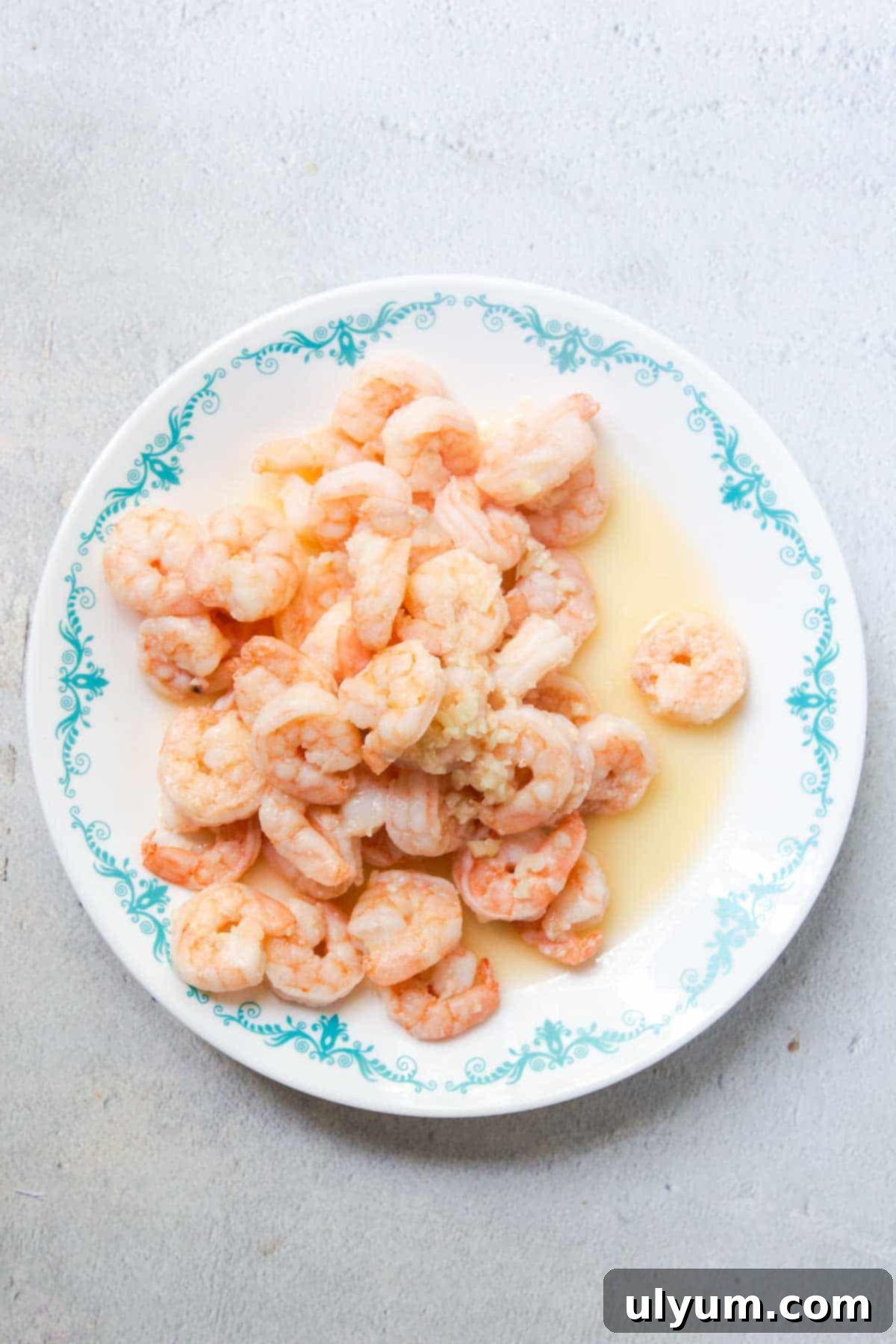
3. Rest the Shrimp: Once the shrimp are opaque pink and curled, indicating they’ve reached an internal temperature of 145°F (62.8°C), promptly remove them from the pot and transfer them to a plate. Setting them aside prevents them from becoming rubbery and overcooked as the pasta simmers.
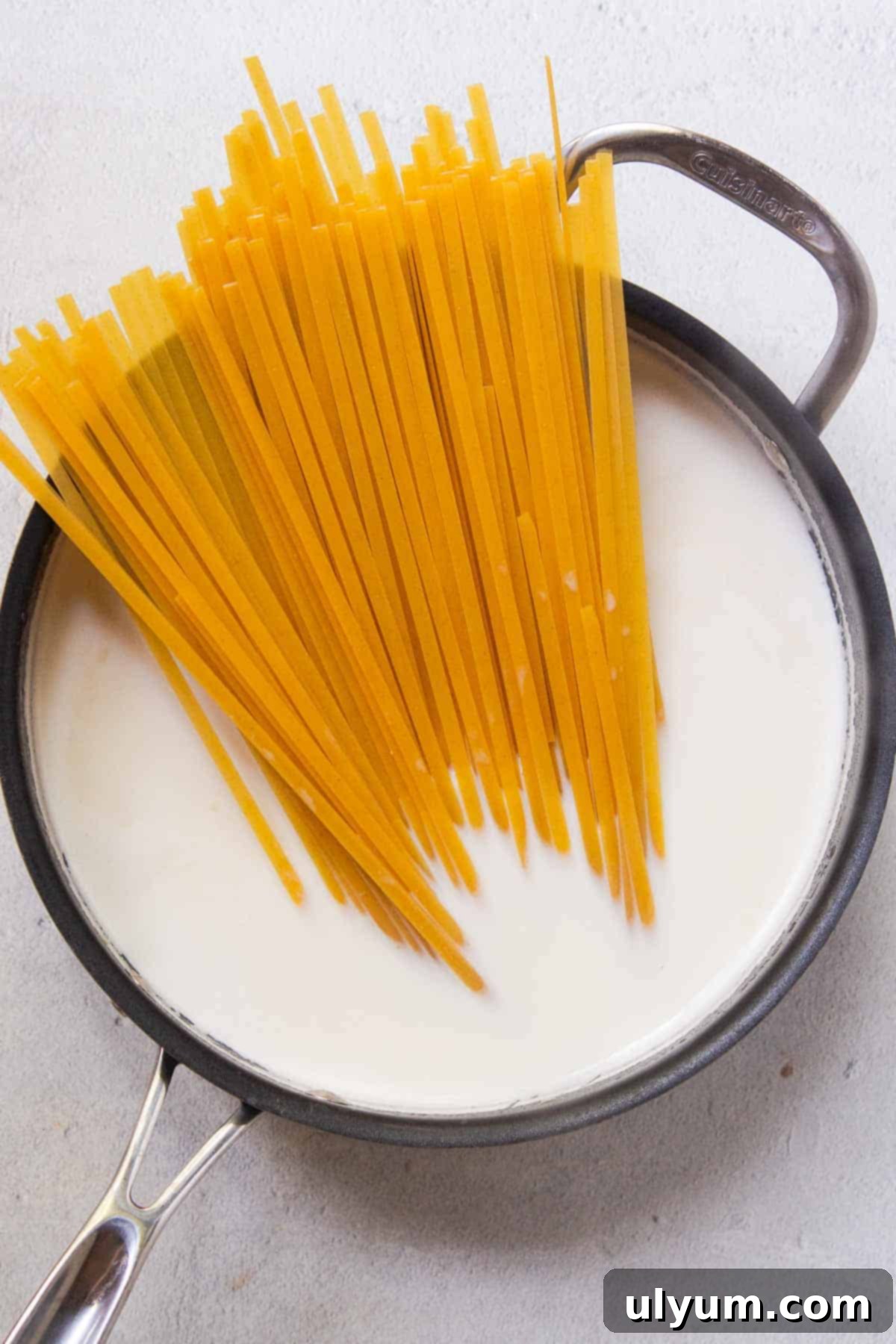
4. Cook the Pasta: Using the *same pot* (which now holds all that delicious butter-garlic residue), add the milk and chicken broth. Bring the mixture to a low boil over medium to medium-high heat. Once simmering, add the uncooked fettuccine, making sure it’s submerged as much as possible. Reduce the heat to low, cover partially, and let it cook for about 15 to 20 minutes, or until the pasta is al dente and most of the liquid has been absorbed, creating a creamy sauce.
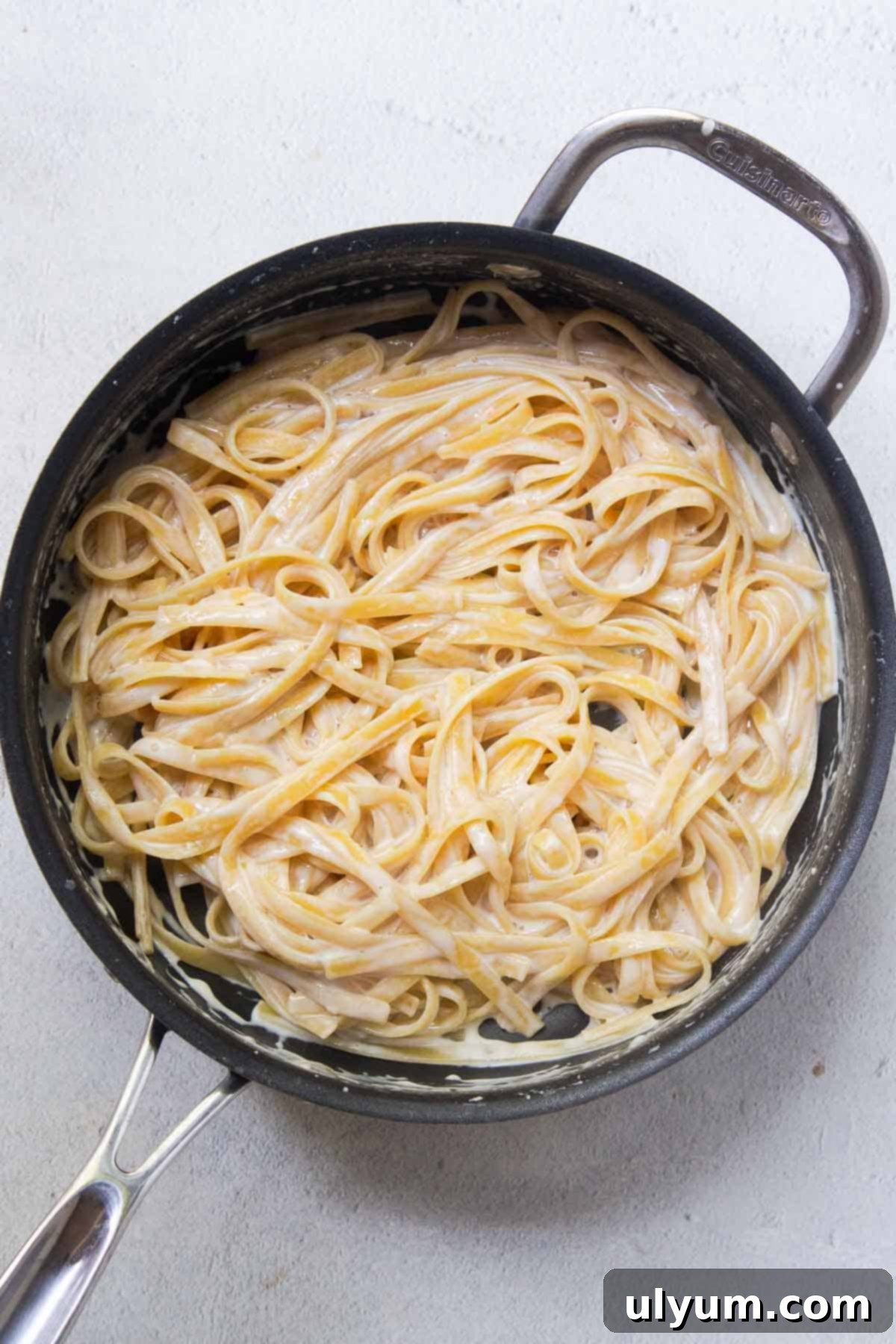
5. Stir and Check: Stir the pasta occasionally during cooking to prevent it from sticking to itself or to the bottom of the pot. Ensure the liquid reduces and thickens, coating the pasta. Once the pasta is perfectly cooked to your desired al dente texture and the sauce has reached a lovely creamy consistency, remove the pot from the heat.
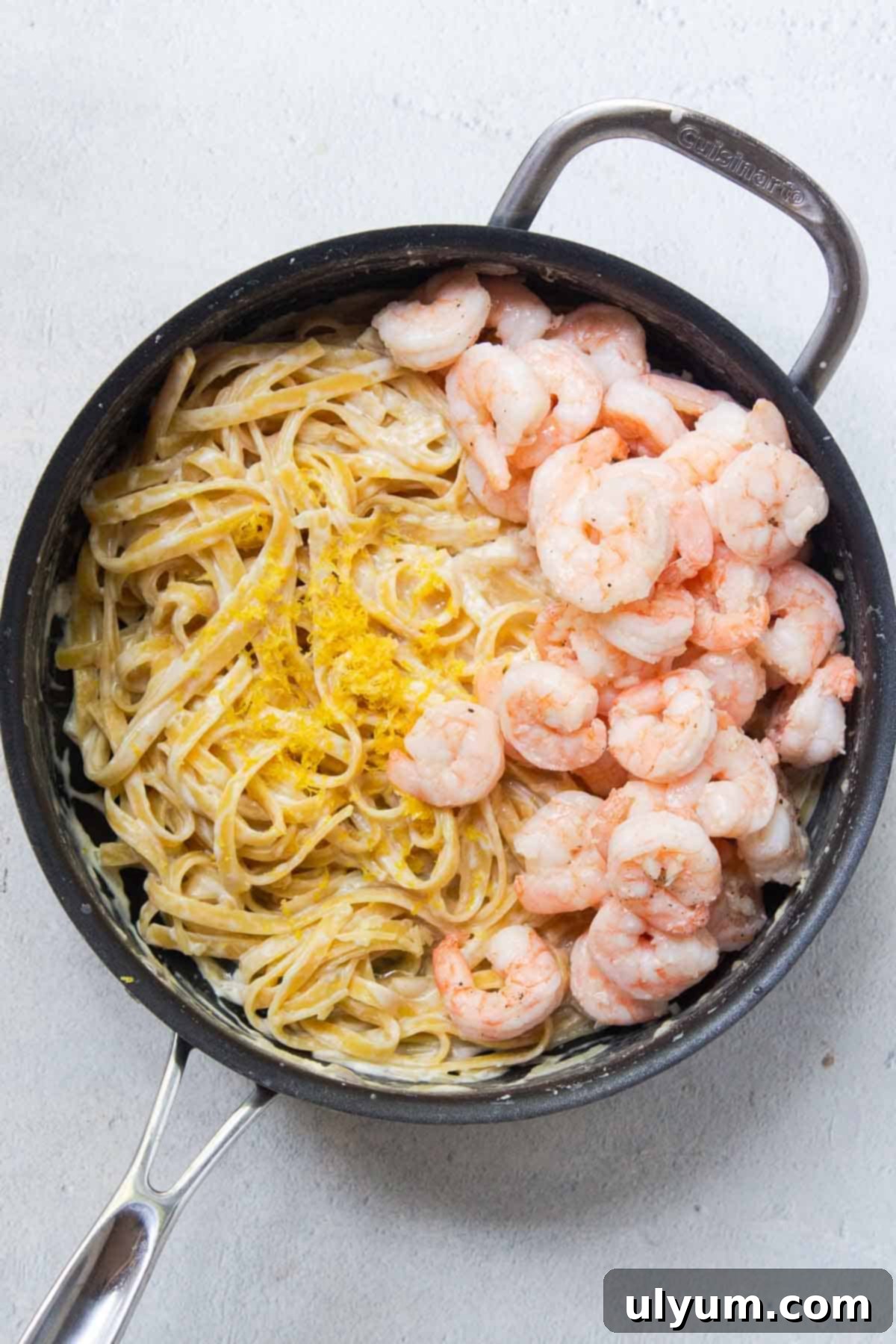
6. Finish and Serve: Off the heat, add the shredded Parmesan cheese, fresh lemon juice, lemon zest, and the cooked shrimp back into the pot. Stir gently until the Parmesan cheese has fully melted into the sauce, making it extra rich and creamy. Taste and adjust seasoning with additional salt and pepper if needed. For an extra touch of freshness, garnish with chopped fresh parsley before serving.
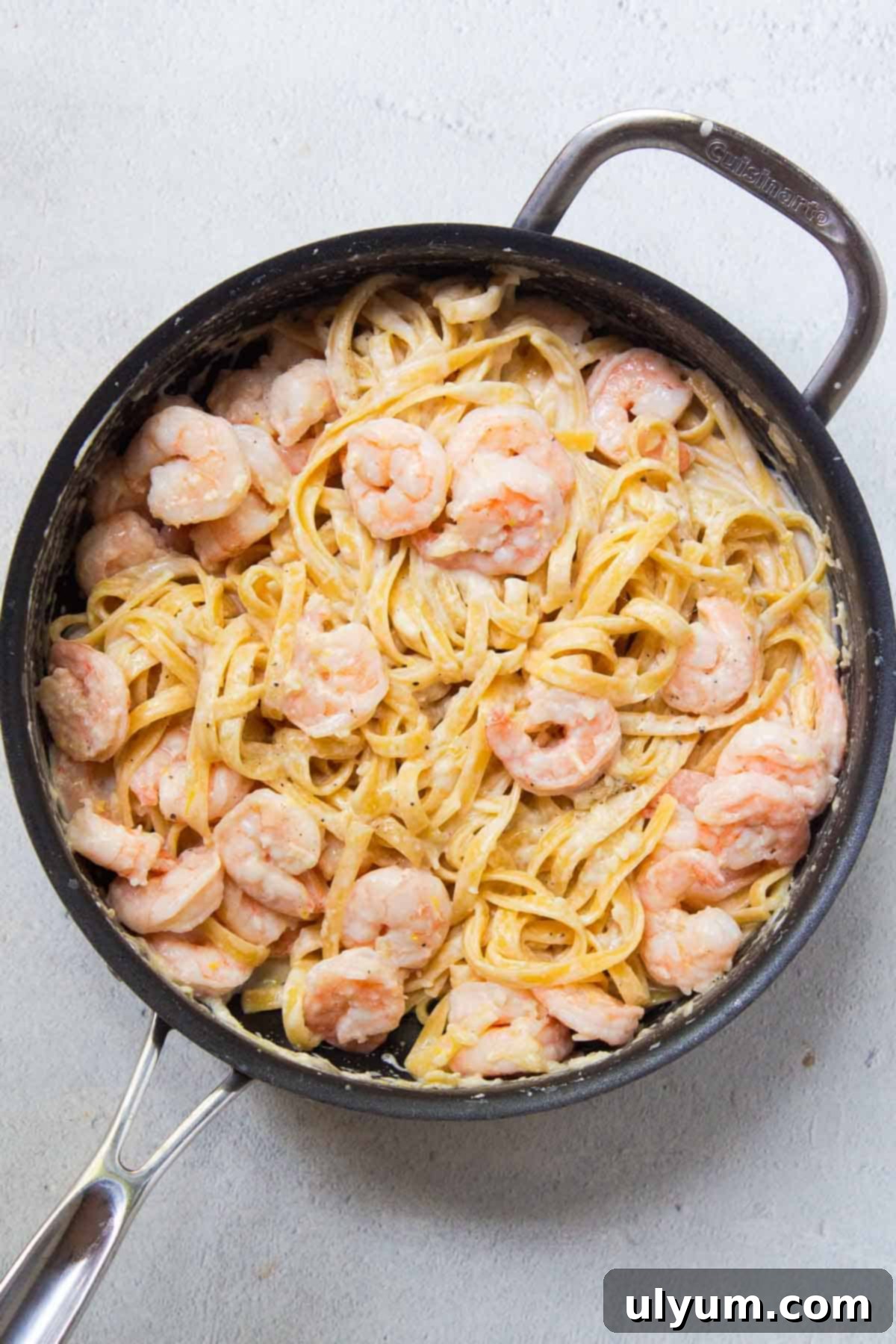
Garnish with fresh parsley if desired for a burst of color and herbaceous note.
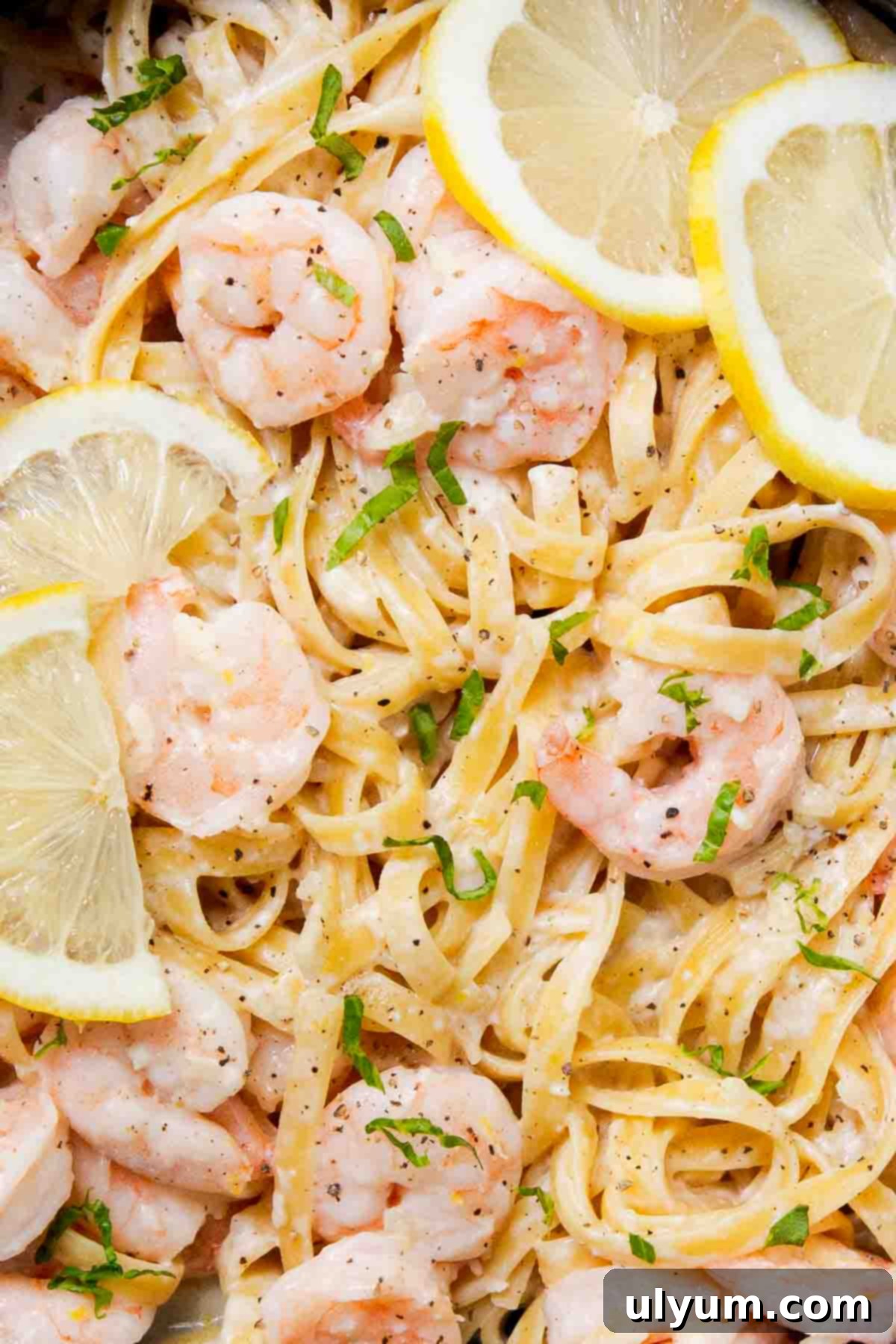
Flexible Substitutions for Your Pantry & Preferences
Don’t have every ingredient on hand? No problem! Here are some excellent substitutions that will still yield a delicious meal:
- Butter Alternatives: If you’re out of butter, **olive oil** can be used for sautéing. A combination of butter and olive oil also works beautifully, offering the richness of butter with a slightly lighter profile.
- Shrimp Options: While raw shrimp is ideal, **pre-cooked shrimp** can save you precious cooking time. If using pre-cooked, ensure it’s thawed according to package instructions and patted dry. Briefly toss the cooked shrimp in the melted butter and season, then set aside and add back at the end, just to warm through. For a different protein, consider **scallops** or even diced **chicken breast**, adjusting cooking times accordingly.
- Milk Substitutes: If you prefer to omit milk or don’t have it, you can use **more chicken broth** for the pasta, but the final sauce won’t be as creamy. To compensate, stir in a splash of **heavy cream** or a tablespoon of **cream cheese** along with the Parmesan and lemon at the end for added richness.
- Broth Variations: **Vegetable broth** or **seafood stock** can be excellent alternatives to chicken broth, each adding a slightly different flavor profile. In a pinch, water can be used, but you’ll likely need to adjust the seasoning with more salt to boost the flavor.
- Pasta Shapes: While fettuccine is fantastic, **linguine, spaghetti, penne pasta, or any other pasta of your choice** will work. Just be mindful that cooking times may vary slightly depending on the pasta shape.
- Cheese Swaps: For a different cheesy note, try **Romano cheese** or **pecorino cheese** in place of Parmesan. These offer a sharper, saltier flavor that complements the lemon and garlic well.
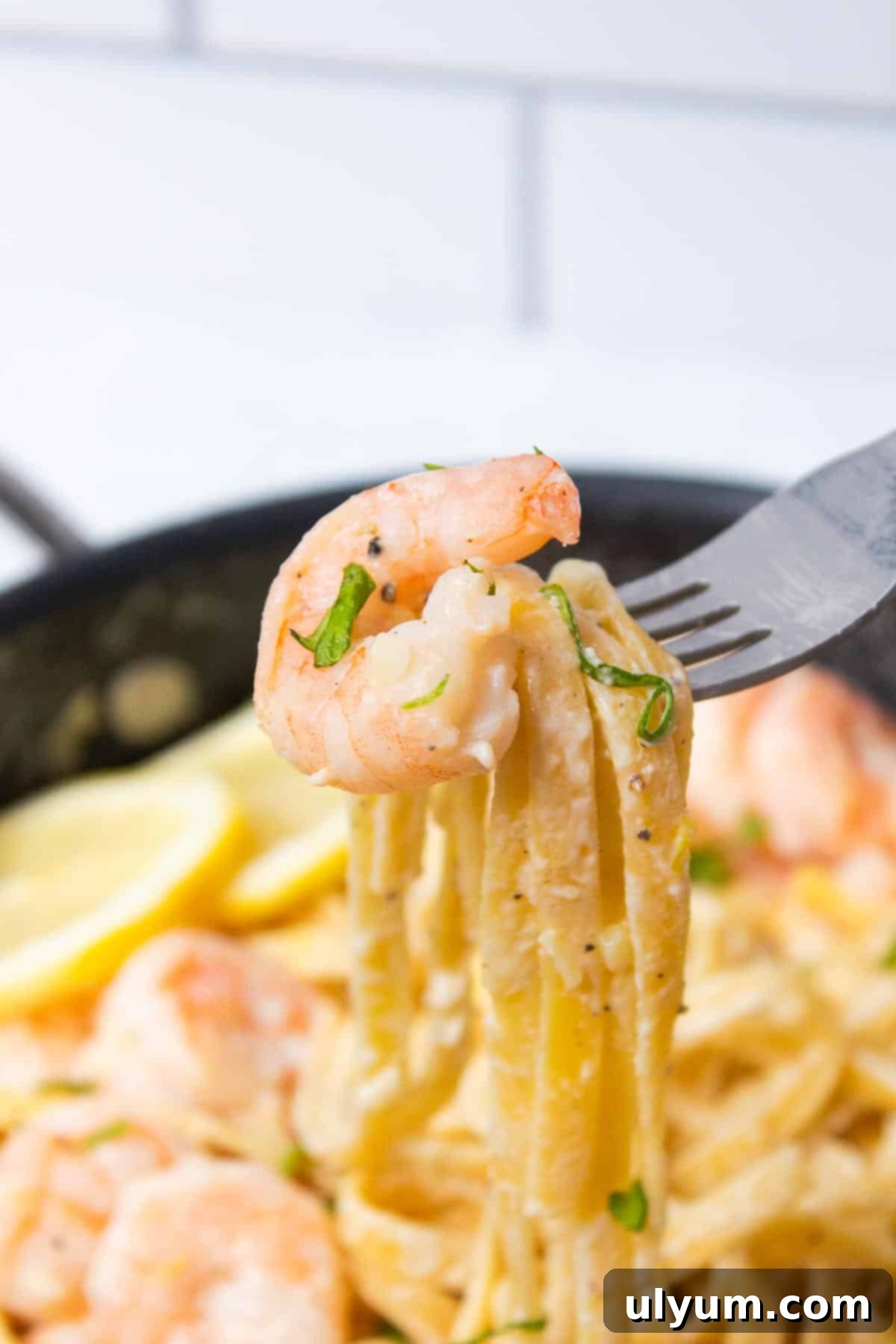
Exciting Variations to Customize Your Pasta
Experiment with these variations to tailor the One-Pot Lemon Garlic Shrimp Pasta to your taste and dietary needs:
- Gluten-Free: Easily adapt this recipe by using your favorite **gluten-free pasta**. Ensure all other ingredients, especially broths, are certified gluten-free. The cooking time for gluten-free pasta might differ slightly, so follow package directions.
- Dairy-Free: To make this dish dairy-free, substitute the butter with **olive oil** or a plant-based butter alternative. Replace the milk with additional **vegetable broth** or an unsweetened plain dairy-free milk (like oat milk or cashew milk) and omit the Parmesan cheese. For a cheesy flavor, try a sprinkle of **nutritional yeast** at the end.
- Pescatarian-Friendly: The recipe is already largely pescatarian! Simply ensure you replace the chicken broth with **vegetable broth** or **seafood stock**. Also, confirm that your Parmesan cheese is vegetarian-friendly, as some contain animal rennet.
- Spicy Kick: If you love a bit of heat, add **1 teaspoon of red pepper flakes** (or more, to taste) when you add the garlic. This will infuse the dish with a lovely warmth that complements the lemon and garlic.
- Tomato Twist: For a vibrant, reddish sauce, incorporate about **½ cup of diced cherry tomatoes** or 1 tablespoon of **tomato paste** when you add the milk and broth. You might also explore recipes like this creamy tomato garlic butter shrimp for inspiration.
- Add Vegetables: Boost your meal with nutritious vegetables! Fresh baby spinach can be stirred in at the very end to wilt. Asparagus spears or sliced mushrooms can be added with the pasta to cook alongside it.
- Fresh Herbs: While parsley is a classic garnish, consider stirring in some fresh chopped **basil** or **chives** with the lemon and Parmesan for additional aromatic complexity.
Essential Equipment for Seamless Cooking
Having the right tools makes all the difference in achieving a perfect one-pot meal. Here’s what you’ll need:
- Large Skillet or Pot: A large, deep skillet (at least 12-inch) or a Dutch oven is crucial for this recipe. It needs to be big enough to accommodate all the ingredients, especially the pasta and liquid, allowing for even cooking and stirring without overflow.
- Cooking Spoon/Spatula: Essential for sautéing the shrimp, stirring the garlic, and ensuring the pasta doesn’t stick while it cooks. A heat-resistant silicone spatula or a sturdy wooden spoon works best.
- Pasta Spoon (Optional but Recommended): A slotted pasta spoon or tongs can be helpful for serving and for testing the pasta’s doneness during cooking.
Storing and Reheating Your Leftovers
To enjoy your delicious One-Pot Lemon Garlic Shrimp Pasta for days to come, proper storage is key. Store leftover shrimp pasta in an airtight container in the refrigerator promptly after cooling, ideally within two hours of cooking. It will maintain its best quality for **3-4 days**. When reheating, gently warm it on the stovetop over low heat or in the microwave. To help maintain its creamy texture and prevent it from drying out, you might want to add a splash of extra milk or chicken broth. Freezing is an option, but be aware that the texture of the shrimp and pasta may become slightly softer upon thawing and reheating.
Frequently Asked Questions About This Recipe
The best pasta for shrimp truly depends on personal preference and the specific dish. For creamy sauces like this one, long strands such as linguine or fettuccine are excellent as they beautifully hold the sauce. Shorter shapes like penne or rotini also work well, especially for heartier shrimp dishes, ensuring every bite gets a piece of shrimp and pasta.
Shrimp pasta pairs wonderfully with simple sides that complement its rich flavors without overpowering them. Classic choices include warm, crusty garlic bread to soak up the creamy sauce, a fresh green salad with a light vinaigrette to add a refreshing contrast, or roasted vegetables like asparagus or broccoli for a balanced and satisfying meal.
Absolutely! Frozen shrimp works perfectly and is often more convenient. Just ensure you thaw it completely before cooking. You can thaw it in the refrigerator overnight or by placing the sealed package in a bowl of cold water for about 30 minutes. Pat the shrimp dry before adding it to the pot to ensure it browns properly.
The key to tender shrimp is not to overcook it. Shrimp cooks very quickly, typically just 2-3 minutes per side. It’s done when it turns opaque pink and curls into a C-shape. In this recipe, we cook the shrimp briefly and set it aside, only adding it back at the very end to warm through, which prevents it from becoming tough and rubbery.
While this dish is best enjoyed fresh, you can certainly prepare components ahead. You could peel and devein the shrimp, mince the garlic, and zest the lemon in advance. The pasta itself is best cooked just before serving to maintain its al dente texture and creamy sauce, as it can absorb too much liquid if left to sit.
More One-Pot Pasta Recipes You’ll Love
Looking for other delightful and easy one-pot recipes? Explore these fantastic pasta dishes that promise flavor and minimal cleanup:
- One Pot Philly Cheesesteak Pasta
- One Pot Italian Sausage Rigatoni
- One Pot Sun-Dried Tomato Pasta
- Instant Pot Tortellini Soup with Sausage
📖 Recipe
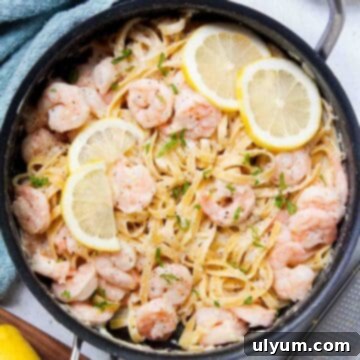
Pin Recipe
Save Recipe
Saved!
Email
Print
One Pot Lemon Garlic Shrimp Pasta
Equipment
-
Large skillet
-
Cooking spoon
-
Pasta spoon
Ingredients
- 2 tablespoons unsalted butter
- 1 pound raw shrimp peeled and deveined
- 4 cloves garlic minced
- 1-½ cups milk
- 1-½ cups chicken broth
- 8 oz fettuccine
- ¼ cup shredded parmesan cheese
- 1 lemon juiced and zested
- Salt and pepper to taste
Instructions
-
In a large pot or a large skillet on medium heat, melt the butter. Add the shrimp and season with salt and pepper to taste.
-
When the shrimp is nearly cooked, add the minced garlic and cook for 1 minute. The shrimp will curl and turn an opaque pink color. Shrimp should be cooked to 145°F (63°C). Pour the shrimp out onto a plate and set aside.
-
In the same pot, add the milk and chicken broth, bringing to a low boil over medium to medium-high heat. Add the pasta and reduce the heat to low, cooking until the fettuccine is al dente, about 15 to 20 minutes. Stir occasionally so the pasta does not stick to itself or to the sides of the pot.
-
When the pasta is cooked, remove it from the heat and add the parmesan cheese, lemon juice, lemon zest, and cooked shrimp, stirring until the cheese is melted. Salt and pepper to taste. Garnish with fresh parsley if desired.
Video
Notes
Storage: Store leftover shrimp pasta in an airtight container in the refrigerator promptly after cooling. Consume within 3-4 days, reheating with care to retain its flavor and quality. Freezing is possible but may affect shrimp texture upon thawing.
Nutrition
Important Food Safety Tips
Ensuring food safety is paramount when cooking with seafood. Please observe the following guidelines:
- Safe Thawing Practices: If you are starting with frozen shrimp, always thaw it safely. The best method is to place it in the refrigerator overnight. For quicker thawing, submerge the sealed package of shrimp in cold water, changing the water every 30 minutes, until thawed. Never thaw shrimp at room temperature, as this can encourage rapid bacterial growth.
- Proper Cooking Temperature: Cook shrimp until it reaches an internal temperature of **145°F (63°C)**. Visually, this means the shrimp will turn an opaque pink color and curl into a C-shape. Overcooked shrimp tends to be tough and rubbery, so keep a close eye on it.
- Prompt Consumption: To ensure optimal safety and quality, consume cooked shrimp within **3-4 days** when stored correctly in the refrigerator.
- Prevent Cross-Contamination: Always use separate cutting boards and utensils for raw and cooked foods. Thoroughly wash your hands, cutting boards, and any surfaces that came into contact with raw shrimp to prevent the spread of harmful bacteria to your cooked dishes.
For more comprehensive information on safe food handling and preparation, please refer to additional guidelines at USDA.gov.
